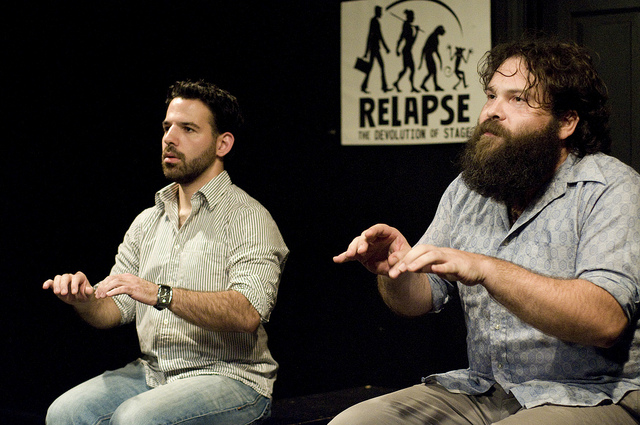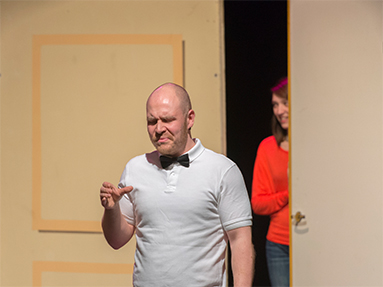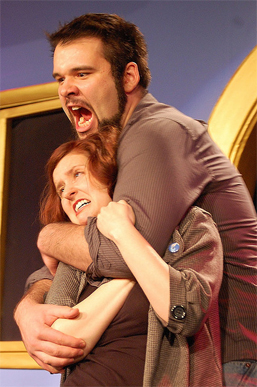
Improv For Everyone instructor Rebecca Lee pulls back the curtain on the art of improvisation and reveals when it comes to the spontaneity of this lively art, chaos is normal and there’s safety in numbers.
The world at large holds a misconception about Improvisational Theatre (improv). It goes something like this, “Improvisational performance is much easier than doing a play—no lines to learn, no sets to build, no props or costumes. You just make it all up as you go along!”
All the above are true, save for insinuation that improv is a breeze because it’s spontaneous performance done on the fly. Believe it or not, there’s actually a technique to how an artist creates through improv and it’s more layered and nuanced than you might think. It’s no less complicated than theatre, it’s just a wider playing field away than one is lead to believe.
Improvisation is a discipline like any other creative endeavor and CE improv instructor Rebecca Lee has been studying it for a greater part of her life. Lee discovered improv as a child. “In 7th grade drama class we played improv games almost every day,” she recalls. “The cute, funny boys would come up with clever, interesting characters who said witty things and I would giggle, turn red, and say nothing. I discovered that I loved watching these games but was too shy to really get involved. It wasn't until my senior year at the University of Washington that I started actually doing improv (in a group called ‘UW Oncue’). That was 15 years ago.”
The siren call to study improv was a persistent one and Lee eventually found herself in Los Angeles auditioning for the Professional Actor's Training Program at the Groundlings. She then switched to the IO West program where she developed a taste for long form improv. Not long after tumbling around with the Groundlings she enrolled at IO West and eventually found herself exploring Musical Improv at the Second City Training Center.
“I love improv even more now than I did back then, both as a form of entertainment and a method of self-improvement. (I don't giggle when I talk to cute boys anymore!)”
Lee says she finds nothing more inspiring than a seasoned team of Improv artists at work. “To an audience member it is almost like magic--kind of like watching a flock of birds who look as if they are reading each other’s minds when they fly together and suddenly shift directions,” says Lee. “Improv actors must use their intuition and make split-second decisions. That is much more exciting than memorizing lines in a play if you ask me!”
They say there are no rules to improve as rules and structure would constrain the creative process, but how it that possible? With no rules, how does one work with a group of other creative minds and not have the whole thing collapse in on itself—especially in front of an audience? Again, an absence of rules is a misconception.
“As an improv student I learned that YES, there are many rules to improv, but they can be broken if you know how to break them properly,” says Lee. “After years of experience and training from various teachers, I have come to the conclusion that the rules (to improv) are not nearly as complex as the ones that I paid hundreds of dollars to learn. Instead of ‘Don't do this’ or ‘Don't do that’, I think the only rules are ‘Do something’ and ‘Respond to what your scene partner just did’. Almost every improv actor will say that the number one rule in improv is ‘Yes, and...’ I have found that different schools and theaters have differing opinions of how to define "Yes and..." which is why I say instead: ‘Respond to what your scene partner just did’. However, I still consider it a great philosophy and I teach many ‘Yes, and...’ games in my classes.”
Before one can properly break the rules, one has to learn to play the game. Part of playing that game is being familiar with its language. Here’s a sampling of the terminology improv artists use in their work, 
- Offers: Anything a character does or says on stage in an improvised scene. It could be a line or a physical gesture.
- Showing VS Telling: Generally this means that the action is currently happening within the flow of the scene, rather than the characters stepping outside the action to talk about a past or future event.
- C.R.O.W: This stands for "Character", "Relationship", "Objective" and "Where". These are crucial elements that make up a successful improv scene.
- Driving: When an improviser is not playing well with the others. They may try to "steer" the scene in a certain direction if they do not trust their scene partner(s).
- Breaking the Routine: Even a good scene can become linear and predictable. In order to freshen it up, a character might do or say something opposite of what might be predicted, in order to "fake out" the audience. Then they would go back to their original point of view.
- “Yes, and…”: Accepting an offer as true and adding on to it. The healthy give and take within an improvised scene
Lee says a fear of disaster or potential chaos is pointless because walking the edge of uncertainty is the whole point of improv. “I would say that is part of the fun of improv. My favorite improv coach always told our team to ‘Play Recklessly’. You can do anything you want without suffering consequences. There are no lines to remember, no set pieces to protect, and you can even mime taking off your clothes without offending anyone.”
And that’s what makes studying improvisational performance a tremendous fun, but no less challenging than any other form of theatre.
Learn more about Improv for Everyone.
Photo credit #1: Jackpie Improv Comedy
Photo credit #2: Finland Improv
Photo credit #3: Angela Manginelli